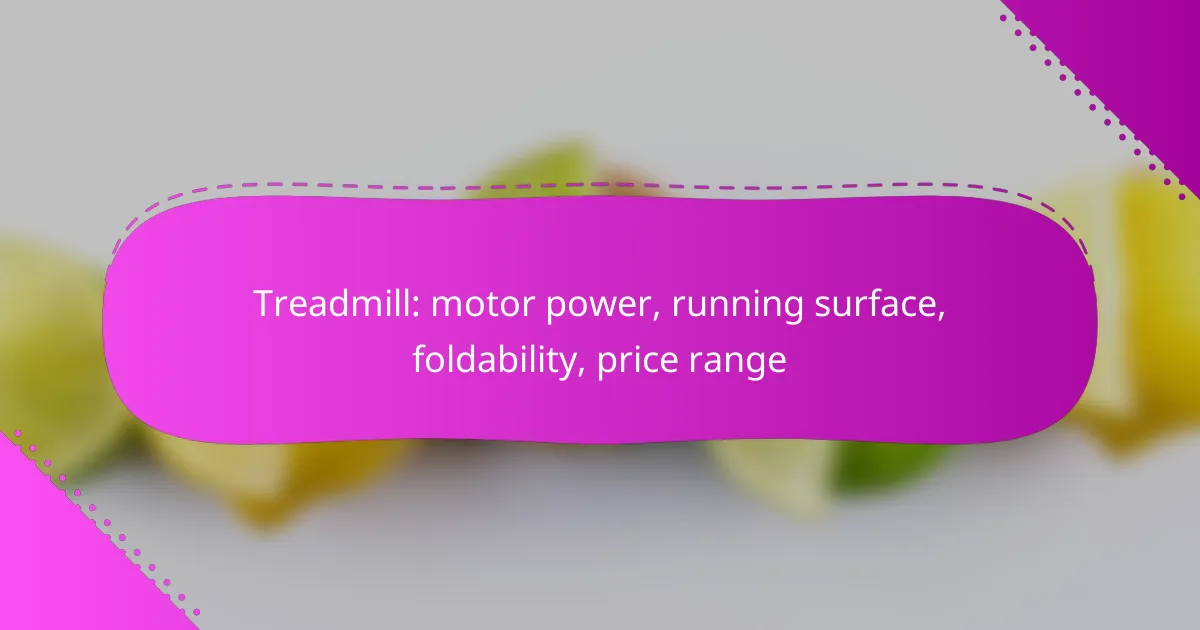When choosing a treadmill, it’s essential to consider factors such as motor power, running surface, foldability, and price range. A motor power between 1.5 to 3.0 horsepower is ideal for home use, providing the necessary performance for various workout intensities. The running surface impacts comfort and injury risk, while foldability offers practical storage solutions for smaller spaces. Understanding these features can help you find the perfect treadmill to suit your fitness needs and living situation.

What is the ideal motor power for treadmills in Australia?
The ideal motor power for treadmills in Australia typically ranges from 1.5 to 3.0 horsepower (HP) for home use. This range ensures sufficient performance for various workout intensities while accommodating different user weights and running styles.
Recommended motor power for home use
For most home users, a motor power of 2.0 to 2.5 HP is generally sufficient for walking and jogging. If you plan to run frequently or have multiple users, consider a treadmill with at least 2.5 HP to ensure durability and performance. Higher motor power can also provide a smoother experience, especially during interval training.
Commercial treadmill motor power standards
Commercial treadmills usually feature motors with a power rating of 3.0 HP or higher. This is necessary to withstand continuous use in gyms and fitness centers, where machines are often in operation for many hours each day. These higher standards help maintain performance and reduce wear and tear on the equipment.
Impact of motor power on performance
The motor power directly affects a treadmill’s ability to handle different speeds and inclines. A more powerful motor can sustain higher speeds and support heavier users without straining. Additionally, treadmills with higher motor ratings tend to have better longevity and require less maintenance over time.
When choosing a treadmill, consider your fitness goals and the intensity of your workouts. A treadmill with insufficient motor power may lead to overheating and reduced performance, especially during high-intensity sessions.

What running surface should I choose for my treadmill?
The running surface of a treadmill is crucial for comfort and performance. It affects your workout experience, injury risk, and the overall durability of the machine.
Types of running surfaces available
Common types of running surfaces include rubber, vinyl, and cushioned materials. Rubber surfaces are durable and provide good traction, while vinyl is often easier to clean but may not offer as much shock absorption. Cushioned surfaces, designed for comfort, can significantly reduce impact on joints.
Benefits of cushioned running surfaces
Cushioned running surfaces are designed to absorb shock, reducing the strain on your knees and joints during workouts. This can be particularly beneficial for individuals with a history of injuries or those who prefer longer running sessions. Additionally, these surfaces can enhance comfort, making workouts more enjoyable.
Durability of different running surfaces
The durability of a treadmill’s running surface varies by material. Rubber surfaces typically last longer under heavy use, while cushioned surfaces may wear out faster but provide better comfort. Regular maintenance, such as cleaning and lubrication, can extend the life of any running surface, regardless of its type.

How does foldability affect treadmill usability?
Foldability significantly enhances treadmill usability by allowing for easier storage and transport. A foldable treadmill can save space in smaller homes or apartments, making it a practical choice for users with limited room.
Benefits of foldable treadmills
Foldable treadmills offer several advantages, including convenience and versatility. They can be easily stored away when not in use, freeing up valuable floor space. This feature is particularly beneficial for urban dwellers or those with multi-purpose rooms.
Additionally, many foldable models are designed with lightweight materials, making them easier to move around. This portability allows users to relocate their treadmill for cleaning or to change their workout environment, such as moving it from a living room to a garage.
Top foldable treadmill models in Australia
In Australia, some of the top foldable treadmill models include the NordicTrack T Series and the ProForm Performance series. These models are known for their sturdy construction, user-friendly features, and compact design.
Another popular option is the Reebok Jet 100, which combines a solid running surface with a foldable frame, making it ideal for home use. Prices for these treadmills typically range from AUD 600 to AUD 1,500, depending on the features and specifications.

What is the price range for quality treadmills?
The price range for quality treadmills typically spans from a few hundred to several thousand dollars, depending on features and specifications. Budget models may start around $300, while high-end options can exceed $2,000, offering advanced technology and durability.
Budget-friendly treadmill options
Budget-friendly treadmills usually cost between $300 and $800. These models often feature basic motor power, smaller running surfaces, and limited workout programs. They are suitable for light use, such as walking or occasional jogging.
When choosing a budget treadmill, look for a motor with at least 2.0 HP for adequate performance. Foldability can also be a key feature, allowing for easier storage in smaller spaces.
Mid-range treadmill features
Mid-range treadmills typically range from $800 to $1,500 and offer a balance of quality and functionality. These models often include more powerful motors, larger running surfaces, and advanced features like heart rate monitors and multiple workout programs.
For serious runners, a motor with 2.5 to 3.5 HP is recommended. Many mid-range treadmills also provide foldability and enhanced cushioning systems for better joint support during workouts.
High-end treadmill specifications
High-end treadmills generally cost over $1,500 and can go up to $5,000 or more. These machines are designed for frequent use and often include features such as high horsepower motors, expansive running surfaces, and advanced technology like interactive screens and Bluetooth connectivity.
Look for motors above 3.5 HP for optimal performance, especially for intense training. High-end models often come with superior build quality, extensive warranty options, and features like incline adjustments and customizable workout programs to enhance the running experience.

What factors should I consider when buying a treadmill?
When buying a treadmill, consider motor power, running surface, foldability, and price range. These factors significantly influence performance, convenience, and overall value.
Key features to evaluate
Motor power is crucial as it determines the treadmill’s ability to handle different speeds and inclines. Look for motors rated between 2.0 to 4.0 horsepower for home use, with higher ratings suitable for more intense workouts.
The running surface size affects comfort and safety. A belt width of at least 20 inches and a length of 55 inches is recommended for most users, providing ample space for various running styles.
Foldability is important for those with limited space. Treadmills with hydraulic folding mechanisms are easier to store and can save significant floor space when not in use.
Brand comparisons for treadmills
Popular treadmill brands like NordicTrack, ProForm, and Sole offer a range of models catering to different budgets and needs. NordicTrack is known for its interactive features and high-quality build, while ProForm often provides more budget-friendly options without sacrificing essential features.
Sole tends to focus on durability and straightforward functionality, making it a solid choice for users who prioritize reliability over advanced tech. Compare warranty offerings, as reputable brands typically provide warranties ranging from 1 to 10 years on parts and frames.
When evaluating brands, consider customer reviews and service support, as these can greatly impact your long-term satisfaction with the treadmill. Look for brands with positive feedback on durability and customer service responsiveness.

How do I maintain my treadmill for longevity?
To maintain your treadmill for longevity, regularly clean and lubricate the running surface, and check for any wear and tear. Following a consistent maintenance schedule can help prevent issues and extend the life of your equipment.
Regular maintenance tips
Start by cleaning the treadmill after each use to remove dust and debris from the running surface and motor area. Use a soft cloth and mild cleaner, avoiding harsh chemicals that could damage the machine.
Lubricate the running belt every few months, or as recommended by the manufacturer, to reduce friction and wear. Check the owner’s manual for specific lubrication guidelines and use the appropriate lubricant type.
Inspect the treadmill’s power cord and connections regularly for any signs of damage. Make sure to tighten any loose screws or bolts to ensure stability during use.
Common treadmill issues and solutions
One common issue is a slipping belt, which can occur due to improper tension. If this happens, consult the manual for instructions on how to adjust the belt tension correctly.
Another frequent problem is an error code on the display. Refer to the user manual for troubleshooting steps specific to your model, as different brands may have unique error codes and solutions.
If the treadmill makes unusual noises, it could indicate a need for lubrication or a mechanical issue. Stop using the machine and investigate the source of the noise before resuming workouts.

What are the latest trends in treadmill technology?
The latest trends in treadmill technology focus on enhanced user experience, connectivity, and performance tracking. Innovations include smart features, improved motor power, and foldable designs that cater to space-saving needs.
Smart treadmill features
Smart treadmills now often come equipped with connectivity options such as Bluetooth and Wi-Fi, allowing users to sync their workouts with fitness apps. These features enable real-time tracking of metrics like heart rate, calories burned, and distance covered, providing a comprehensive view of fitness progress.
Many models also incorporate interactive screens that offer virtual training sessions and scenic routes, making workouts more engaging. Users can choose from various programs tailored to different fitness levels, enhancing motivation and adherence to exercise routines.
When selecting a smart treadmill, consider the compatibility with your preferred fitness apps and the quality of the display. Look for models that offer regular software updates to ensure access to the latest features and improvements.
